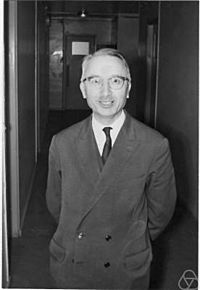Henri Cartan facts for kids
Quick facts for kids
Henri Cartan
|
|
|---|---|

Henri Cartan in 1968
|
|
| Born |
Henri Paul Cartan
8 July 1904 Nancy, France
|
| Died | 13 August 2008 (aged 104) Paris, France
|
| Nationality | French |
| Alma mater | École Normale Supérieure |
| Known for | Cartan's theorems A and B Cartan's lemma Cartan–Eilenberg resolution Projective module Steenrod algebra Weak dimension |
| Awards | Peccot Lectures (1932) Émile Picard Medal (1959) |
| Scientific career | |
| Fields | Mathematics |
| Institutions | University of Paris |
| Thesis | Sur les systèmes de fonctions holomorphes a variétés linéaires lacunaires et leurs applications (1928) |
| Doctoral advisor | Paul Montel |
| Doctoral students | Jean-Paul Benzécri Pierre Cartier Jean Cerf Jacques Deny Adrien Douady Pierre Dolbeault Roger Godement Max Karoubi Jean-Louis Koszul Jean-Pierre Ramis Jean-Pierre Serre René Thom |
Henri Paul Cartan (born July 8, 1904 – died August 13, 2008) was a famous French mathematician. He made very important discoveries in a field of math called algebraic topology.
He came from a family of smart people. His father, Élie Cartan, was also a mathematician. He had an aunt and siblings who were also mathematicians, a composer, and a physicist.
Contents
Henri Cartan's Life Story
Henri Cartan loved mathematics from a young age. He said his family didn't even need to push him! When he was five, his family moved to Paris. This was because his father got a job at the Sorbonne university. Henri went to high school in Versailles.
Education and Early Career
In 1923, he started studying math at a top school, the École normale supérieure. He earned his teaching degree in 1926. Then, in 1928, he got his PhD. His main teacher was Paul Montel.
After finishing school, Cartan taught at different universities. He taught in Caen and Lille. From 1931 to 1939, he taught in Strasbourg.
World War II and Later Years
During World War II, France was invaded. Henri Cartan moved to Clermont-Ferrand with his university. But in 1940, he returned to Paris. He worked at the University of Paris and the École Normale Supérieure. He continued teaching there until he retired in 1975.
Henri Cartan lived a very long life. He passed away on August 13, 2008, at 104 years old.
Awards and Recognition
Henri Cartan received many honors for his work. In 1932, he was invited to give a special lecture series. He led the French Mathematical Society in 1950. From 1967 to 1970, he was president of the International Mathematics Union.
Major Awards
He won several important awards:
- The Émile Picard Medal in 1959.
- The CNRS Gold Medal in 1976.
- The Wolf Prize in 1980.
He was also asked to speak at big international math conferences. These included events in Zürich (1932), Cambridge, Massachusetts (1950), and Edinburgh (1958).
Memberships and Honorary Degrees
From 1974 until he died, he was a member of the French Academy of Sciences. Many other countries also invited him to join their science academies. These included the Royal Society in London and the National Academy of Sciences in the United States.
He also received special degrees from many universities around the world. These are called Honorary Doctorates. Some of these universities were Münster, ETH Zürich, and Cambridge.
The French government also gave him high honors. He was named a "Commander" in several important orders. These included the Légion d'honneur.
Helping Others and European Unity
Henri Cartan used his influence to help people. In the 1970s and 1980s, he worked to free mathematicians who were imprisoned. These scientists were held in places like the Soviet Union and Uruguay. For his efforts, he received a human rights award in 1989.
Building Bridges After War
After World War II, Cartan worked hard to bring French and German mathematicians together. He wanted them to share ideas and help students. He believed in cooperation between countries.
Supporting European Unity
Cartan also supported the idea of a united Europe. He was the president of the French section of the Union of European Federalists. In 1992, he gave a speech at a math conference in Paris. He talked about how European countries share a common history and future. He was happy to see mathematicians from both sides of the Iron Curtain finally meeting.
His Mathematical Work
Cartan worked in many areas of mathematics. These included algebra, geometry, and analysis. He focused a lot on algebraic topology and homological algebra.
Bourbaki Group and Teaching
He was one of the first members of a famous group of mathematicians called Nicolas Bourbaki. After 1945, he started his own special math seminar in Paris. This seminar greatly influenced many younger mathematicians. Some of his students became very famous, like Jean-Pierre Serre and René Thom.
Key Discoveries
Early in his career, Cartan studied complex numbers. He developed important ideas about sheaf cohomology. He proved two powerful results known as Cartan's theorems A and B.
Later, he became very interested in algebraic topology. He helped create the idea of the Steenrod algebra. With Jean-Pierre Serre, he developed a method called "killing homotopy groups." He also wrote an important book with Samuel Eilenberg on homological algebra. In this book, they introduced ideas like projective modules.
Cartan also made contributions to other areas of math. He introduced the ideas of filter and ultrafilter in general topology. He also worked on potential theory.
Images for kids
See also
 In Spanish: Henri Cartan para niños
In Spanish: Henri Cartan para niños


